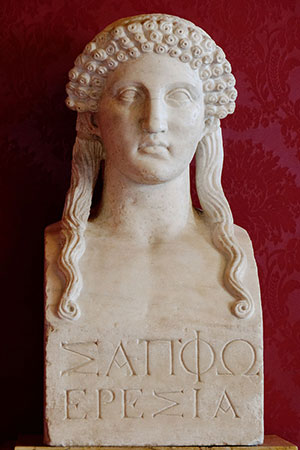LESBIANISM expressed through literature is not a modern conception. In fact, it can be said that literature of this kind has existed for as long as there has been women poets – which goes all the way back to ancient times with Sappho, and maybe even much further back. While lesbianism has been present in the literary arts for a long time, the ways in

which it was expressed and the mechanisms through which it was expressed have varied considerably. Poets often write to appeal to a certain time, a certain place and a certain audience, but only truly great poetry can become universal, surviving, existing, and influencing regardless of place and time. Sappho, the Greek lyrical poet, whose works dealt with the love of women, exists in this particular category of poets.
Sappho is one of the earliest poets whose work contains aspects of lesbian relationships. One of her poems, I have not had one word from her (trans. Mary Barnard) is a particularly good poem to use in analying Sappho’s presentation of lesbians since it is neatly connected to her belief system and its influence in her poetry, as was discussed in last week’s article.
Interestingly, the persona of I have not had one word from her seems to incorporate the goddess of love and a representative of Sappho’s belief system, Aphrodite, into her own relationship, in a few brilliant lines, when she tells her female lover to “think of all our gifts to Aphrodite / and all the loveliness we shared”.
The “we” in the line could be read as referring to the persona, her lover, and Aphrodite herself. One reason why Sappho may have done this is to hint at the strength of the love between the women in the poem – it is so powerful that it calls upon the goddess of love to partake in it. It seems almost as if the characters worship the goddess in such a way so that she almost becomes part of their union. Clearly, Sappho is intent on showing the divine nature of lesbian love and the way it should be celebrated, in a holy manner that is implied by the presence of Aphrodite.
Apart from highlighting the strength of her emotions, Sappho might have been using that particular line from her persona to show how beautiful the general love between women is. The presence of the goddess of love in a poem that is about a lesbian relationship was definitely an attempt by Sappho to show how sacred she believes these types of relationships to be. To further emphasise this point, we must pay attention to the subtle use of imagery in the poem.
The images that elaborate on all the “loveliness shared” between the women in the poem follows directly in the lines after and, according to the persona, include, “…violet tiaras, / braided rosebuds, dill and / crocus twined around your young neck / myrrh poured on your head…” Flowers are obviously emblems of love, but they can also be used in religious offerings and this interpretation is underscored by the presence of myrrh, a notoriously religious item, as part of the love-making activities that these women take part in.
Sappho is obviously attempting to fuse the religious aspect of her life with the sexual aspect in order to sanctify lesbian relations, in order to show how lesbian love is as sacred as worship. Such is the kind of love that is expressed in Sappho’s poetry, the kind that is both sensual and religious. Sappho makes it difficult to navigate between the two and that, clearly, is her intention. She wants her listeners to view relationships and love as sacred and religious. If this is an indicator of the status of lesbians in ancient Greece then it should not be difficult to understand why Sappho draws on Aphrodite for so much of her poetry and why her poems are exalted in such a way so as to present lesbian relationships as being akin to the divine. Sappho’s portrayal of lesbianism is mostly religious, written in language that often sound like invocations and prayers, usually sanctified with the appearance or plea to Aphrodite, or a comparison of the persona’s young lover to a goddess.
Today, and in other periods of our literary history, the idea of writing poetry that fuses lesbian love and the divine might seem sacrilegious, but Sappho’s poems are filled with imagery and emotions that bring the two together. I have not had one word from her is one of many, and when one reads the poem in its entirety one cannot help wondering what verses, what gems, might have been lost through the ages when one comes across only fragments of her work, even when they are as simple and powerful like the line in a fragment which simply reads: “You burn me.”



.jpg)










